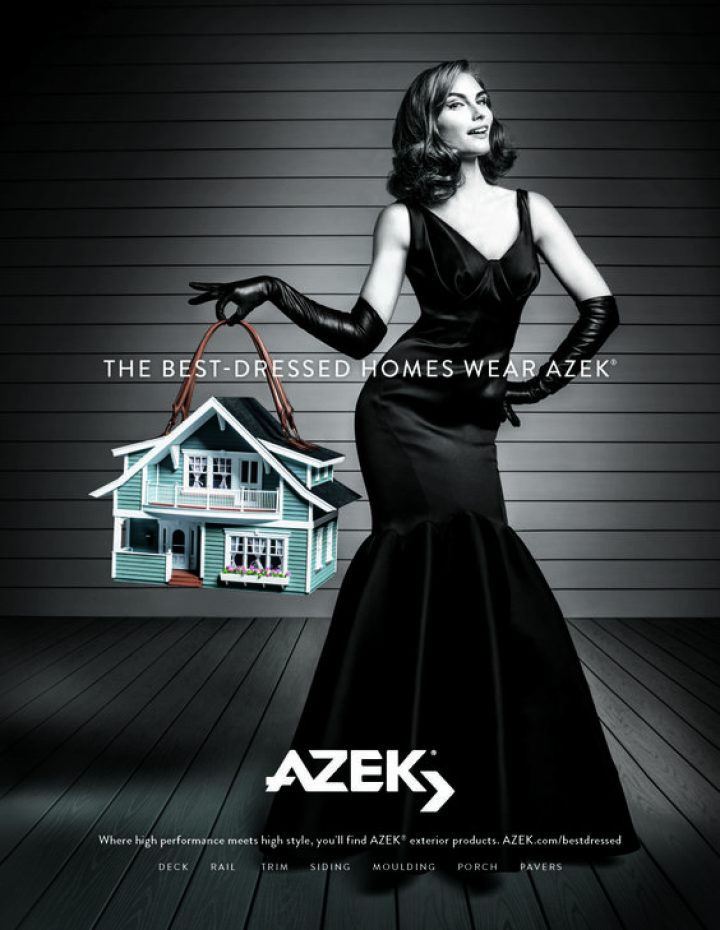
Why was Azek at New York Fashion Week?

Always fascinating to see an ad fail and ponder what might have led up to it. We recently noticed that this year New York Fashion Week was greeted by Azek – a new advertiser hoping to reach women. But for Azek, a brand unknown to consumers, the campaign fails on advertising basics: There’s no reason to remember their name or care about what they might say.
So let’s imagine how this all came about.
The background: Azek makes home building products from recycled material – like “capped cellular PVC” decking, trim, moldings, railings, and even driveway pavers. They rolled out a new campaign (including outdoor, print, and social) with the launch centered around one of fashion’s most iconic events: New York Fashion Week.
Why, you may ask? Azek CMO Julia Fitzgerald explains in a video (link here): “The Azek team knows that it’s not just important to dress yourself well, it’s important to dress your home well. And the best-dressed homes wear Azek.”
Based on that comment, here’s my guess at the fundamentals: (1) Azek wants to target female homeowners who care about their home’s aesthetic and curb appeal; (2) their products are premium products for higher end homes; (3) Azek wants a campaign that is going to shake things up and go “outside of the box”.
It’s also a change for Azek to target end consumers, not the professionals who create homes and decks with the product. The influence of professionals may, in fact, be the most critical driving factor in Azek’s business. (Rather than discuss this critical choice in this post, I think we learn important realities about advertising if we consider how this campaign came about.)
Here’s my take on the likely brainstorm sessions that led to this answer.
“Custom railings, molding, trim and decking dress up a home.”
- Yes, but let’s not take this too far. Unfortunately creative teams love clever analogies more than consumers. Unable to restrain that urge, the creatives arrive at: “Fashion is to decking as a dress is to a woman”.
- The team also fails to realize this is a very limiting view of consumer benefits of these home products. I wouldn’t bet my campaign for these products on “fashion”.
“We are targeting women.”
- That may be smart marketing. But watch out. This is where historically male-targeted companies screw up. Tool companies make hammers that are pink “to appeal to women”. And fishing companies create mauve waders “because those are women’s colors”. Never forget that female buyers prefer good products to pink products.
“Let’s tie the advertising to an event women pay attention to…NY Fashion Week!”
- Uh oh. Now things are getting out of hand. Someone thinks all women are keyed into fashion week? And thinks women will connect better with the ads because they are tied to fashion week? Poor strategic choice. And, just maybe, this is “dumbing down advertising” with an assumption that the way to a woman’s consideration list is through fashion. That’s a very limiting view of women in my marketing experience.
“To execute…the ad will feature a high fashion woman holding…what else, a custom-trimmed house-purse…and we’ll put decking in the background.”
- Disaster is now apparent. The image is dominated by the woman in the dress. Clearly they hit the “fashion” idea. But will I remember Azek or connect it to a meaningful product?
- The decking/siding isn’t present. If you look long enough you see it there in the background faded into muddled obscurity. Looks to me like this part of the failure comes from embracing a concept that couldn’t be executed well.
- Then there’s the weird doll house purse. It looks strange. And it takes a lot of thinking before consumers might ever guess it’s there to show Azek trim and siding. Far too subtle.
- That said…if only they were selling that dress!
Maybe the mere fact of advertising will be enough?
I’m sure this is wrapped up in a new branding effort and the numbers of impressions and click rates will dazzle. But, will it lead to change? Will it lead to sales? Will it influence any women (or men) to figure out who Azek is and why they should care?
I can’t see any of that happening. If they were Snickers, then the mere presence of the advertising might be pretty significant. But they aren’t Snickers and they have a big problem: people don’t really know who they are.
Sadly this illustrates a very common problem. Having spent 20 years of my life working with home products I’m constantly shocked at how poorly big agencies handle them. And I’m shocked that manufacturers continue to follow these agencies down the rabbit hole.
Far too often consumers are bombarded with fantasies that come out of a creative director’s imagination. These fantasies reflect “hot ideas” that make sense inside the agency echo chamber and fail with consumers. Here, vast sums of client money are wasted on a fantasy that a woman engaged in Fashion Week during the frigid month of February will jump to online deck shopping.
Advertising can, and should, radically improve business for companies like Azek.
Azek needs advertising to create brand presence and drive consumption of their building products. And having worked with home product companies, I know how hard it is to get significant ad budgets at a company like Azek. So it’s sad to see a hard won budget wasted like this.
Fortunately, Azek makes great products and pros may be their most important purchase influencers. So while this ad budget may not have the powerful impact they hoped for, it won’t hurt the foundation of their business. I hope they find a more productive strategy next year.
Copyright 2016 – Doug Garnett – All Rights Reserved
Categories: Advertising, Brand Advertising, Business and Strategy, Innovation

Posted: December 17, 2017 18:56
Ellen